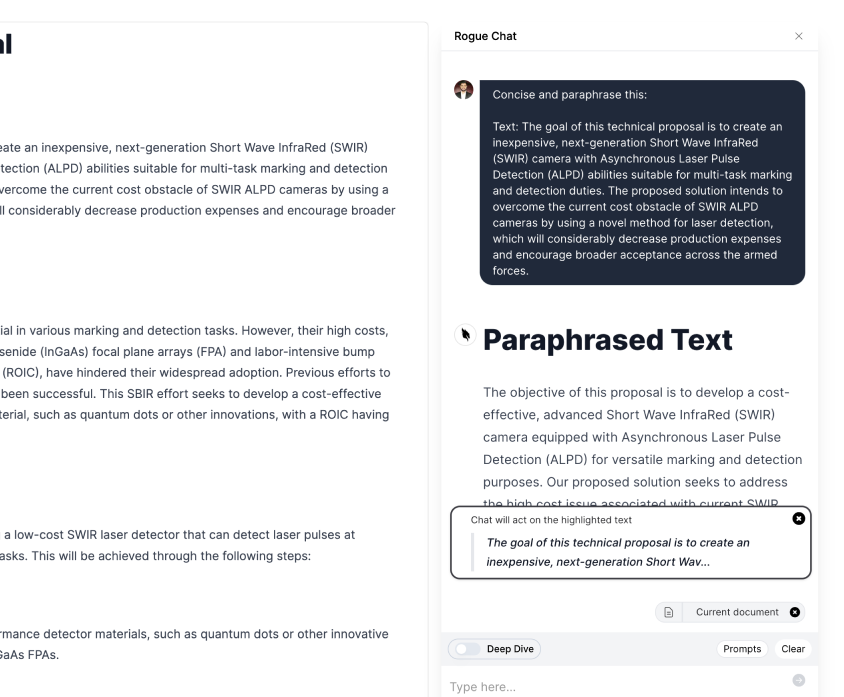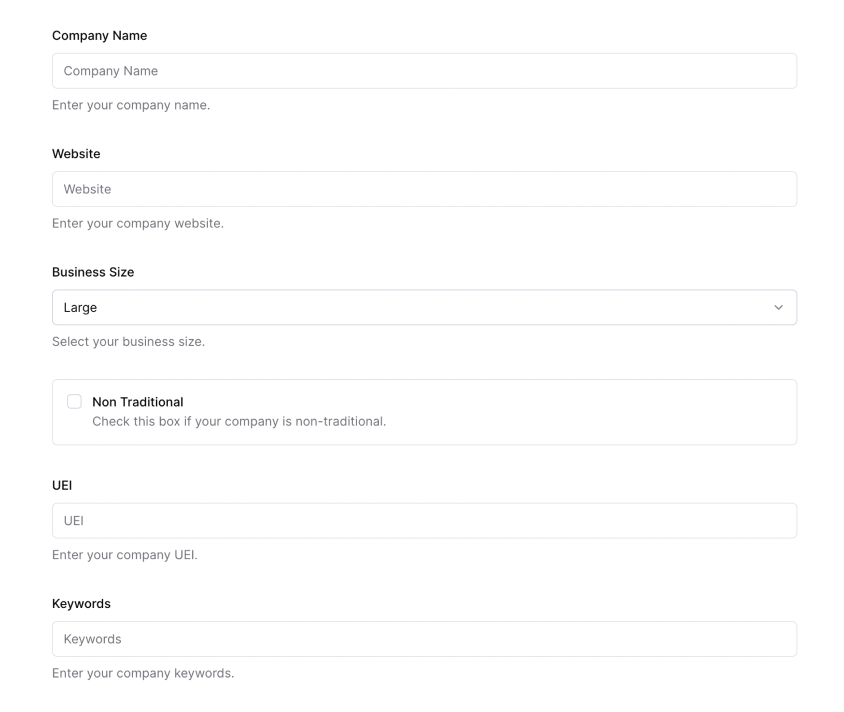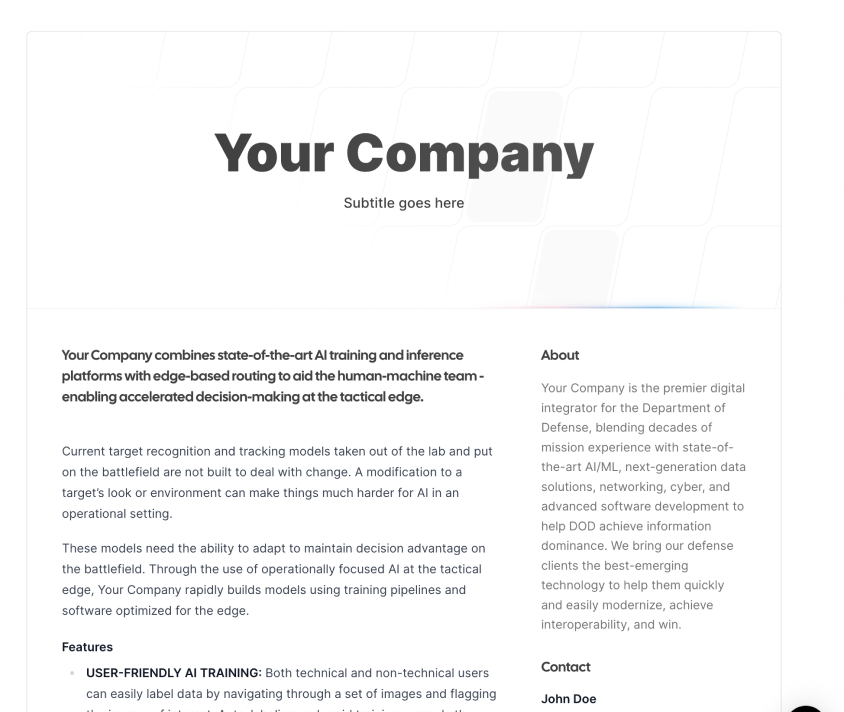
Module 1.a: The Value Proposition of Generative Models for GovCon Professionals
©️You are free to adapt and reuse provided (1) that you provide attribution and link to the original work, and (2) you share alike. This course and all of its contents are the property of UseRogue.com and are offered under the Creative Commons BY-SA 4.0 License.
Introduction
Working with the government has many necessary but often labor-intensive task for many professionals. The processes involved are highly manual, which can lead to inefficiencies and increased costs. However, the emergence of Artificial Intelligence (AI) and Generative Pre-training Transformers (GPTs) presents a unique opportunity for optimization and efficiency.
Let’s start by getting over a often traded myth “AI is going to take everyone’s jobs”. Computer’s didn’t take typist’s jobs, they made them less laborious, the same is true for AI. Here’s a great article from the Harvard Business Review that goes over the topic. Now what is true, as we alluded to in the last section, AI-adepts WILL replace those who are not, but that’s why you’re here.
So how do we translate this into terms that make sense? How much more valuable will you be if you know how to use AI vs. those who don’t? Whether you’re a business owner, business unit director, or recent college grad, how should you translate your new AI skills into the marketplace?
Let’s do some math and break it down.
I. The Value Proposition of Generative Models
Services
The Federal government typically buys services 1912 hours at a time.
That is 2080 hours (all of the work days a typical year * 8) - 168 hours (11 holidays and 10 days of vacation or 21 * 8 = 168). This is probably common knowledge to those among us who do cost volumes or accounting for a living, but many folks in GovCon are unaware.
So what goes into an hour of time that the government buys for services? Usually just a few things:
- The “direct labor” or the salary of the person who’s services they are buying. If this is you, take your salary, divide it by 2080, and you’ll know what you cost in “direct labor” to the government.
- Next is “fringe benefits” things like health insurance, 401k, etc.
- Then overhead costs to provide those services, which includes things like a company issued computer, management and supervision for that specific client, etc. Anything that a person needs in order to provide services to the government.
- Then general and administrative costs of running the company that provides those services, think the accountant, the lawyer, the bookkeeper all of the business development folks.
- Finally a profit or “fee” on top.
The end total is the actual “rate” that the government pays.
📣Wonk Note:
In proposal parlance (for those of you not doing BD) everything other than the direct labor is called a “wrap”, you will hear people talking about their “wrap rates”, which is short hand for saying how much you multiple direct labor by to get the final number you charge the government. Most wrap rates are between 1.7 and 2.3.
To illustrate, if a person makes $100,000 per year, their direct labor is 100,000/2080 = 48.08.
Now, a company with a moderate wrap rate, say 1.9 will charge the government $48.08*1.9 = $91.35 this is called the “fully burdened” or “fully wrapped” rate.
The $43.26 per hour they charge goes to pay for the office building, HR, advertising, paid time off, taxes, etc.
Companies with “lower wraps” or a lower “wrap rate” are generally more competitive
Note: there are different ways to calculate fully burdened rates, this is not a cost estimation master class, this is just an illustration.
Products
The government goes about buying products in many ways, ranging from commoditized pens and pencils to hand-built F35 joint strike fighters.
At the end of the day, how they pay for products is largely the same as services, except that you add in things like materials, handling, plant and equipment, supplies, etc. They still pay for the people producing, packaging, and delivering those pencils and stealth fighters, but the cost is typically rolled up in a per-unit cost of the product rather than just the time of the person.
“why are you telling me this?”
Do you or your company provide products or services to he government, if so where do you fit?
Are you at a client site or directly supporting them or building something your company sells? If so, you are the direct labor and fringe part of this equation.
Are you managing personnel who provide products or services to the government? if so you may be overhead.
Are you working at the corporate office managing paperwork and processes? if so you’re probably general and administrative.
You are not a material or piece of equipment, so your cost to your company, and thus your cost to the government, is typically charged under one of these headers: direct labor, overhead, general and administrative.
Think of yourself in terms of how your company charges the government, not the most fun, but important for this exercise.
Here’s the important part: companies that can offer the same products and services as the next company at a lower cost are more competitive, they will win more.
If you can help your company be more competitive and win more, you are more valuable. If you are more valuable then your employer will be willing to pay you more.
How much more? We’ll get to that next.
III. The Business Case for Generative Models
Think about your job, your daily tasks. Imagine the things that take a fair amount of time but not a lot of critical thinking. Drafting responses to emails, writing reports, memos, forms, taking notes, building slide decks. Think of them all; all of the tasks where your eyes and hands are very busy, but the analytical part of your brain is not - low value work.
Now imagine how much of your time is consumed by those things. Give it a number. 1 hour per day, 2 hours?
If you’re a manager (Overhead or “O/H)” or work at a corporate office (general and administrative “G&A”) its probably a lot.
How many hours per day do you spend on mundane tasks that you WISH an AI would do for you?
Think deeply about this for a few minutes, start writing them down. Not an exhaustive list, just the first ten things that come to mind.
Make your top ten list and put a number of minutes per day on average you think you spend on those low-value things. Include infrequent things that consume a lot of low-value time, think monthly status reports, major slide decks, and CDRL documents.
📣Wonk note:
CDRLs or “C-drills” are Contract Data Requirements List items that contractors are contractually required to deliver to the government. They are often painful to create but contractually mandated to deliver - important.
IV. Do the Math
Ok you have a list of ten things, you should have a daily time number for your top ten low-value tasks.
Now multiply that by 239 (the number of typical work days in a year), lets call this x.
Ok, now lets assume that once you’ve acquired the skills of this course you can cut the time suck of these tasks by 50%, so x * 0.5 = y
Y is how much time you are saving the company or the government for the SAME amount of VALUE.
This assumes that you are not going to save y and then watch cat videos with your newfound time, people like that tend not to take master classes in AI-powered productivity. We assume that you are going to reinvest your newfound time into supporting your company or customer mission, which means for the same COST your company or customer will get more VALUE.
You will be the person who gets the report done in an hour rather than a day, turns the slides in early rather than late. You have spare capacity to help the boss because you breeze through tasks that consume your peers. People who do things 50% faster are very easy to see.
Good work begets good work, so you will quickly become the relied upon person, the valuable person.
Now lets go back to our wrap rate discussion, take your annual salary, divide it by 2080, and then multiply it by 1.8 (lets be conservative) and get your “fully burdened rate”, lets called that z.
So, multiply y * z to find out in broad terms how much you can save your company in cost, whether that cost is passed to the government as billed hours, or diffused into a corporate wrap rate. You now have a hard figure.
Asking for a raise? bring hard numbers with you.
Want a promotion, talk about your value on top of your skills.
If you contribute to adding revenue and/or reducing costs, you equal profit.
If you can quantify how much value you added because you leveled up your skills with AI then perhaps you can make a case for 10% of the value your proactivity added.
V. Become More Competitive
Being pro-AI and embracing technologies like generative models will be crucial for future competitiveness in the job market. Those who resist this shift may find themselves at a disadvantage as AI continues to become more integrated into our daily work lives.
Moreover, as businesses become more digital and automated, companies that adopt AI early could gain an edge in the marketplace. With the ability to automate routine tasks, these companies can focus on innovation and strategic growth—key factors that will define success in the future business landscape.
The value proposition of generative models for GovCon professionals is clear: they offer a way to accelerate mundane tasks, free up humans for more critical thinking tasks, lower costs, increase productivity, and boost profitability.
As we move towards an increasingly digital future, embracing AI—and specifically generative models—will become not just an option but a necessity for those looking to stay competitive in the job market and business landscape.
The future is here now. The question is: Are you ready to embrace it? Don't get left behind—start exploring how AI and generative models can help optimize your work processes today. The possibilities are endless!
VI. Practical Exercise
- If you haven’t, make your top ten list from section 3, it is important for orienting you to the highest value sections of this course
- Post your list in the LI group
- Find someone else in the group who shares at least one item with you and comment on their list - build the community
- Do the exercise from section 4 and find your prospective value add.
- Vary the wrap rate between 1.7 and 2.3 and productivity increase from 10%-8% for your top ten list, see what value range you get. This will give you a benchmark for how much progress you can make in this course. This is for you, not for the group, this is your personal benchmark with which to challenge yourself.
- Leave feedback below
GovCon GPT Masterclass
31 lessons
Sign up for Rogue today!
Get started with Rogue and experience the best proposal writing tool in the industry.



